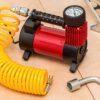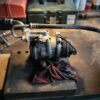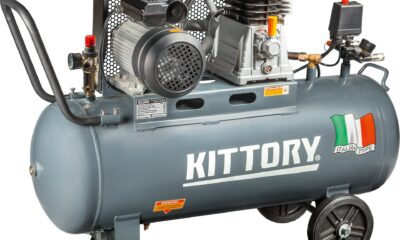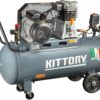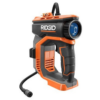Technical terminologies go over our heads when unfamiliar with them. Not to worry, as this article will help you understand what CFM is and what role it plays in an air compressor. Let’s get started.
What Is CFM In Air Compressor?
One of the key specifications to consider when selecting an air compressor is its CFM rating. CFM, which stands for cubic feet per minute, measures the volume of air the compressor can deliver per minute. It is an essential factor to consider because it indicates the compressor’s ability to provide a certain volume of air per unit of time.
CFM is measured at a specific pressure level, known as the compressor’s rated pressure. The rated pressure is the maximum pressure that the compressor is designed to deliver, and the CFM rating decreases as the pressure increases. So, the CFM is inversely proportional to the pressure. If you need a higher pressure output from your compressor, you must choose a higher CFM rating to compensate for the decrease in air volume.
What Role Does CFM Play?
The CFM rating of an air compressor is an important aspect when using a compressor. Here are some key roles that CFM plays in the context of air compressors:
Performance Of Tools
Different pneumatic tools, such as impact wrenches, paint sprayers, and nail guns, have specific CFM requirements. If the CFM delivered by the air compressor is below the requirement, the tool may not function properly. Matching the CFM rating of the compressor with the tool’s CFM requirement ensures proper tool performance.
When using multiple tools simultaneously, the total CFM requirement increases. Each tool may have its CFM requirement, and the cumulative CFM demand should be within the limits of the air compressor. Ensuring that the compressor can deliver the required CFM for simultaneous tool operation is crucial to maintaining tool performance and avoiding air pressure drops.
Efficiency and Duty Cycle
The CFM rating also affects the efficiency and duty cycle of the air compressor. If the compressor continuously operates below its CFM capacity, it may lead to inefficiencies and excessive wear on the components. On the other hand, if the demand exceeds the compressor’s CFM capacity, it may result in overheating, decreased longevity, and potential damage to the compressor. Selecting a compressor with an appropriate CFM rating ensures efficient operation and a suitable duty cycle for the intended application.
Air Pressure
Lastly and most importantly, CFM is measured at a specific pressure level called the compressor’s rated pressure. As the pressure increases, the CFM rating of the compressor decreases. This means that if you require higher air pressure from the compressor, you may need a higher CFM rating to compensate for the decrease in the volume of air delivered at higher pressures.
Is It Necessary To Keep CFM In Mind When Choosing An Air Compressor?
When choosing an air compressor, it’s essential to consider the CFM rating and the type of compressor you need. There are several different types of air compressors, each with its strengths and weaknesses:
- Reciprocating Compressor: This compressor uses a piston and cylinder to compress air. They are available in both single-stage and two-stage models, with the two-stage models offering higher pressure outputs and higher CFM ratings.
- Rotary Screw Compressor: This uses two rotating screws to compress air. These compressors are efficient and quieter than the reciprocating ones, making them a good choice for applications where noise and efficiency are important factors.
Conclusion
To summarize, CFM (Cubic Feet per Minute) is crucial when selecting an air compressor. It represents the volume of air that the compressor can deliver per minute and is measured at the compressor’s rated pressure. Choosing an air compressor with an appropriate CFM rating is essential for ensuring optimal performance and efficiency.
The CFM rating helps determine the maximum pressure at which the compressor can deliver the desired volume of air.
FAQs
1. What does 30 CFM mean on the air compressor?
CFM is a measurement of airflow per minute. For instance, 30 CFM signifies 30 cubic feet of air flowing per minute from an air compressor, also called the output rate.
2. How to convert CFM to HP?
Converting CFM to HP (Horsepower) is simple: Multiply the airflow by 1.6. Then, multiply that product you got by 0.9.
3. How many CFM is in a ton?
One ton of air cooling is equivalent to 400 cubic feet of air per minute(CFM). Two tons of cooling will be double, which is 800 CFM. Multiply the amount you got in tons by 400 to find other conversions.














